Viaducts: new urban encounters
Texte par Tim Abrahams
London, Royaume-Uni
21.08.10
An intelligent approach to repurposing disused viaducts is providing a number of cities with new public spaces that delight users with fresh and intriguing perspectives of familiar urban landscapes. Architonic examines how such projects, in turning us into contemporary flaneurs, make us rethink our relationship with the city.
The High Line in Manhattan, New York's elevated railway viaduct turned remarkable urban experience; photo Irwan Baan © 2009
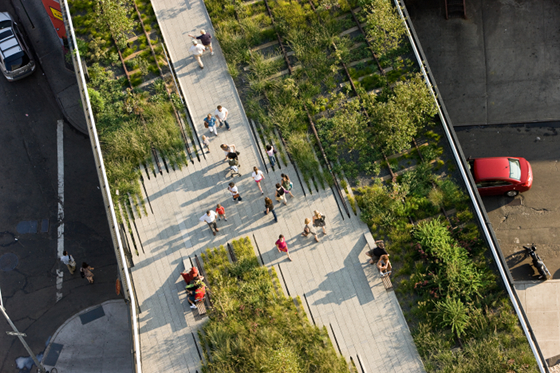
The High Line in Manhattan, New York's elevated railway viaduct turned remarkable urban experience; photo Irwan Baan © 2009
×In 1980, the last train ran on the section of elevated railway in Lower West Side of Manhattan, pulling three carriage loads of frozen turkeys. As property developers and rail enthusiasts debated over the line's fate throughout the decade that followed, the line went to glorious seed. Adam Gopnik, writing in the New Yorker in 2001, noticed how walking along the raised route, covered with weeds and vegetation sprouting from sleepers, reversed the archaeology of Manhattan: “the past is not buried in the ground but held up in the air, on the upper floors”. Viaducts – in this case converted railway lines – have the potential to be exceptional spaces; liminal spaces in which the city can be rethought and reviewed.
The High Line runs for a mile and third through Manhattan's Lower West Side; photo Irwan Baan © 2009
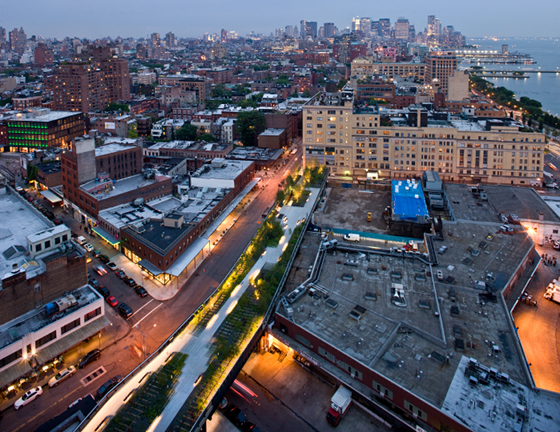
The High Line runs for a mile and third through Manhattan's Lower West Side; photo Irwan Baan © 2009
×The High Line, as this section of railway in New York came to be known, runs only a mile and a third along the western edge of the city, from Thirty-Fourth Street to Gansevoort Street. The elevated section, however, encloses about eight acres. In the short period in which it was untended, the High Line became a much loved space, co-opted by the inhabitants of Manhattan. A designer named Ken Robson, for example, accessed a garden he had created on the track from a gang plank that protruded from his apartment. By this time, Friends of the High Line had been founded to advocate the High Line's preservation and reuse as public open space.
The High Line in 1934; the last train ran along the Manhattan viaduct in 1930, carrying three carriage loads of frozen turkeys

The High Line in 1934; the last train ran along the Manhattan viaduct in 1930, carrying three carriage loads of frozen turkeys
×At the beginning of the last decade, Gopnik was sceptical about the chances. “The Friends of the High Line often say that they would like to see it become a promenade plantée, a long snaking viaduct with flowers, like the one, in Paris, that runs from the Bastille and continues out to the Bois de Vincennes.” The writer expresses a kind of cultural cringe about the likely success of copying the Parisian model in the metropolis of New York. He pointed out that the Promenade Plantée “happens to be above Paris – an elegant flowered walkway looking down on elegant flowered streets – while the High Line is a place where the discordant encounters of its city are briefly resolved.”
Years of neglect of the High Line following its decommissioning in 1980 were reversed when New York architectural office Diller + Scorfidio won a competition in 2003 to develop the structure; photo Joel Sternfeld
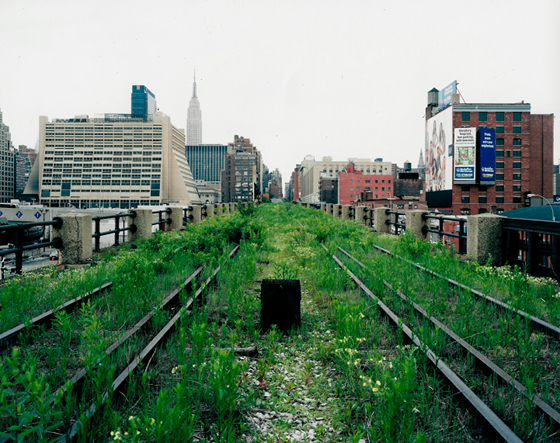
Years of neglect of the High Line following its decommissioning in 1980 were reversed when New York architectural office Diller + Scorfidio won a competition in 2003 to develop the structure; photo Joel Sternfeld
×Of course, in 2010, we now know that the High Line has been a huge success. The process by which the Friends secured public support in the face of fierce opposition from developers, desperate to get their hands on the real estate that could have been realised by the structure's destruction, led to a brilliant design. In October 2002, a study done by Friends of the High Line found that the High Line project is economically rational: new tax revenues created by the public space would be greater than the costs of construction. In July 2003, an open ideas competition solicited 720 different proposals for the High Line's reuse.
The High Line's Northern Spur; Diller + Scorfido treated the existing viaduct structure as a found object, rather than something that required dressing up; photo Irwan Baan © 2009
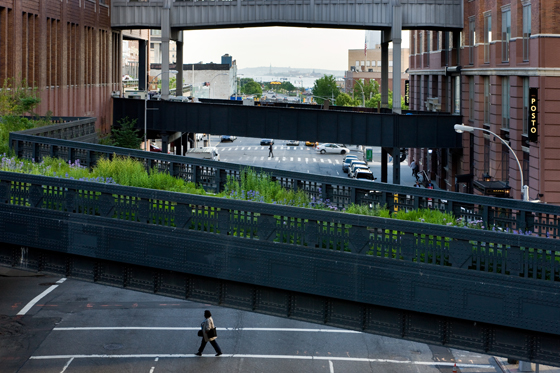
The High Line's Northern Spur; Diller + Scorfido treated the existing viaduct structure as a found object, rather than something that required dressing up; photo Irwan Baan © 2009
×New York architectural practice Diller + Scofidio’s winning entry approached the High Line as a found object, rather than one which needed to be made picturesque. Viaducts by their very nature are always going to provide unexpected perspectives onto the city. The robust industrial materials of the original construction weren’t submerged beneath the new plantings. That said, the High Line project was not cheap. But the £112 million was spent on quality materials: plenty of steel and exposed concrete, occasionally glass. These however, are never used to hide the original purpose of the elevated railway, but, rather, to celebrate it.
The High Line is dotted with pleasant ways to experience urban juxtapositions; photo Irwan Baan © 2009
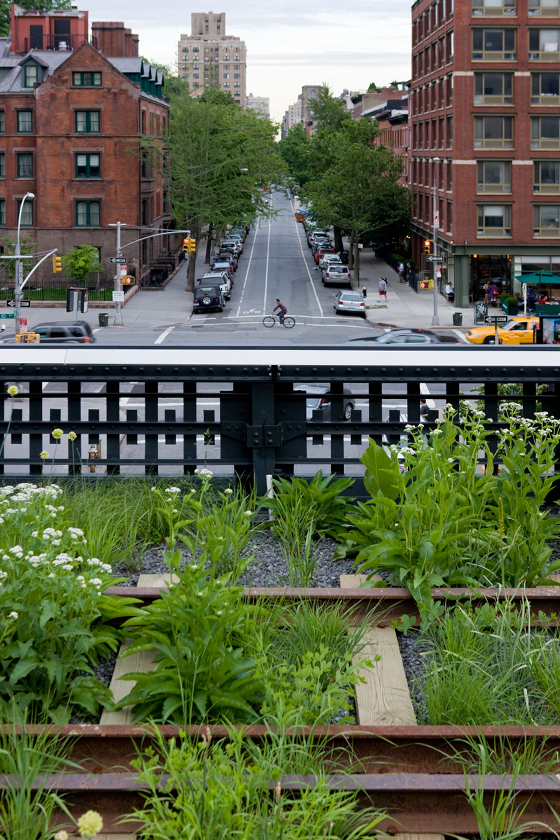
The High Line is dotted with pleasant ways to experience urban juxtapositions; photo Irwan Baan © 2009
×The idea of surprise, found in the unexpected views provided by the High Line, has been added to. The public space at 10th Avenue Square, for example, or the lawn just above 23rd Street. The High Line is dotted with pleasant ways to experience urban juxtapositions. It’s peppered with new vistas and neat entranceways, sun decks and lawns, but the effect is generally to prompt gentle appreciation rather than shock.
Gansevoort Woodland on the High Line; planting on the viaduct, unlike the elevated Promenade Plantée in Paris, is not designed to obscure the urban context; photo Irwan Baan © 2009

Gansevoort Woodland on the High Line; planting on the viaduct, unlike the elevated Promenade Plantée in Paris, is not designed to obscure the urban context; photo Irwan Baan © 2009
×Effectively the High Line became a freestanding piece of urbanism, whereas its predecessor in Paris was part of a bigger strategy. In 1969, the railway from Bastille to Varenne-Saint-Maur, which dated from 1859, was abandoned. A decade later, APUR (or the Atelier Parisien d'Urbanisme) was asked to think about the future of both the SNCF train station at Bastille and the pre-existing, raised brick Viaduc des Arts, which begins on the Rue de Lyon and follows the Avenue Daumesnil.
The Sundeck on the High Line, one of the repurposed viaduct's most popular public spaces; photo Irwan Baan © 2009

The Sundeck on the High Line, one of the repurposed viaduct's most popular public spaces; photo Irwan Baan © 2009
×In fact, the promenade along the top of the Viaduc des Arts, considered to be such an expressive part of Paris’s unique public spaces, was in many ways introduced to preserve the sanctity of the collection of artisans' workshops and retail units that had grown up in an ad hoc fashion underneath it. Destroying the Viaduc in order to construct a series of buildings along the Rue de Lyon and Avenue Daumesnil was rightly rejected. Thus, the idea of maintaining the Viaduc and of creating a promenade began to develop in tandem.
The Friends of the High Line lobbied hard for the viaduct to be rescued from the clutches of private developers' hands; photo Irwan Baan © 2009
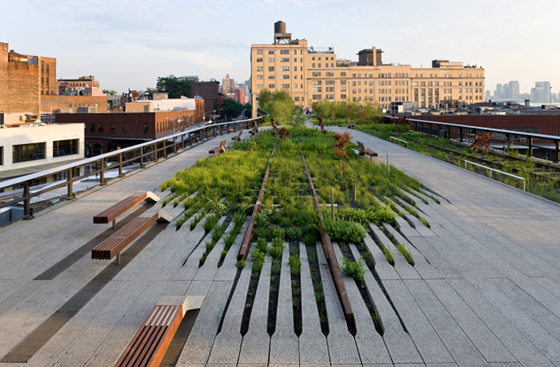
The Friends of the High Line lobbied hard for the viaduct to be rescued from the clutches of private developers' hands; photo Irwan Baan © 2009
×While the High Line was imagined as an exceptional piece of urbanism, that is, something that exists outwith the usual urban fabric and provides views back into it, the Promenade Plantée in Paris was part of a wider urban strategy and this can be seen in the design.
In 1987, the Council of Paris approved the general building principles of the planted promenade and decided to acquire the disused SNCF buildings. In 1990, the Council of Paris also approved the creation of and "officially publicly useful" perimeter around the Viaduc, and several parcels situated just behind it, between the Place de la Bastille and the Reuilly district of the city. The promenade, designed by landscape architect Jacques Vergely and architect Philippe Mathieux, effectively became a huge spine of regeneration.
A study commissioned by the Friends of the High Line established that new tax revenues would outweigh the construction costs for the adapted-viaduct project; photo Irwan Baan © 2009
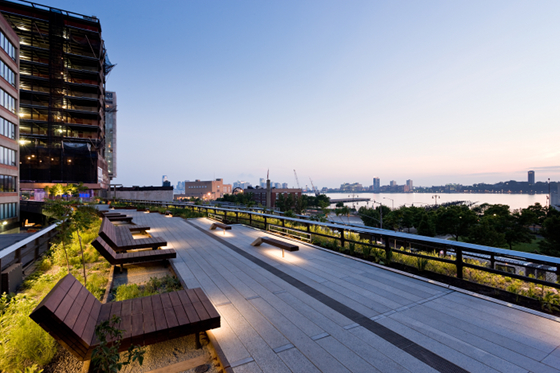
A study commissioned by the Friends of the High Line established that new tax revenues would outweigh the construction costs for the adapted-viaduct project; photo Irwan Baan © 2009
×In landscaping terms, the Promenade Plantée (or Coulée Verte as it is also known) is very traditional. The hierarchy between the pathway and the plantings is fixed. The Bastille end of the path passes through flower borders, symetrical sculptural interventions and archways. The borders often grow so high that the adjacent buildings are obscured. This means that when later sections intersect with modern developments, such as near the Allée Vivaldi, they feel incongruous. That said, the Promenade blends seamlessly with the classic Parisian gardens such as Jardin de Reuilly or the Square Charles-Péguy.
The High Line project continues: the development of the spur between 20th and 30th Streets invites users to enjoy a framed view of 26th Street; design by James Corner Field Operations and Diller Scofidio + Renfro – courtesy of the City of New York
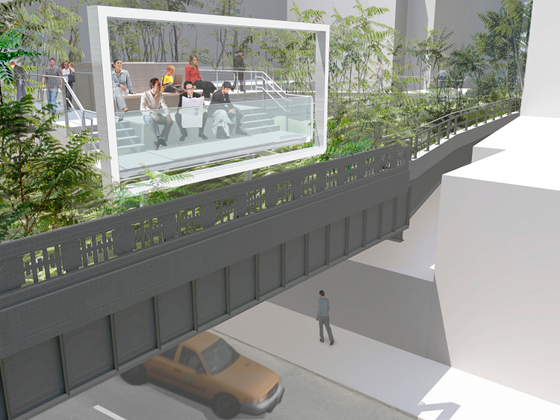
The High Line project continues: the development of the spur between 20th and 30th Streets invites users to enjoy a framed view of 26th Street; design by James Corner Field Operations and Diller Scofidio + Renfro – courtesy of the City of New York
×The Promenade also benefits from a great relationship with the Viaduc des Arts, which was renovated by the architect Patrick Berger simultaneously with the creation of the Promenade. In the 64 vaults beneath the planted promenade are a series of workshops with a surface area of between 150 and 460 square metres for wood, textile, paper and metal artisans. There is a reassuring Parisian quality to this mix. Rather than the mass industry that allowed the railways to be built and Paris to grow, they house instead charming boutiques. Above, lavender bushes cram the borders. Paris is a city that knows how to keep itself at arms length from the unappealing aspects of modern civilisation.
Built for railway traffic in 1859, but abandoned in 1969, the adaption of the Viaduc des Arts in Paris was part of a wider city planning strategy
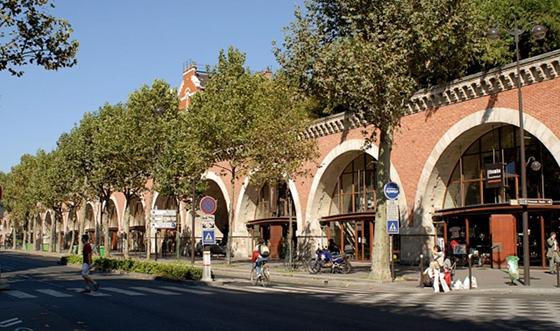
Built for railway traffic in 1859, but abandoned in 1969, the adaption of the Viaduc des Arts in Paris was part of a wider city planning strategy
×Of course, that is not the way of New York – a city proud of its heritage as a glaring, blaring collage of the worst and best of modernity. It is no wonder that High Line is so successful, given that it provides a convenient means of appreciating this aspect of American urban life. It, rather than the Promenade Plantée, is being looked to for inspiration in other American cities.
The Promenade Plantée runs from Bastille to the Paris's Reuilly district and has acted a major spine of regeneration for this part of the French capital
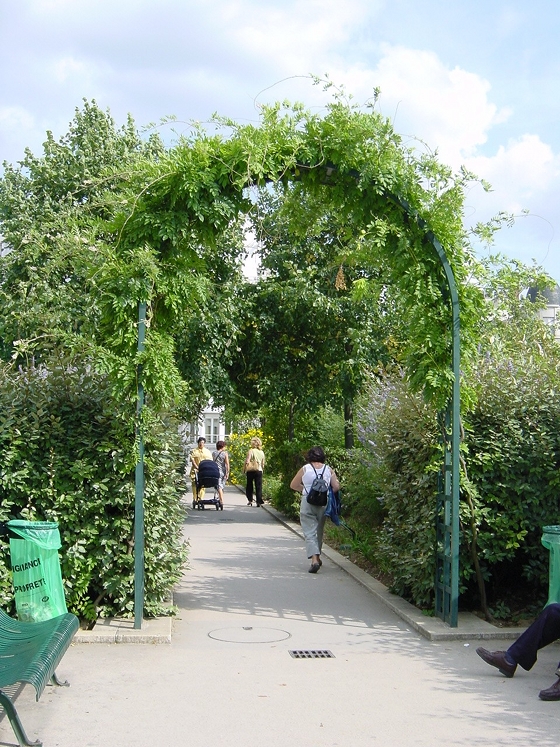
The Promenade Plantée runs from Bastille to the Paris's Reuilly district and has acted a major spine of regeneration for this part of the French capital
×In Philadelphia, plans are afoot to turn the Reading Viaduct, which is 60 foot wide, into an elevated park and bike path. “Our viaduct is much wider, which gives us more opportunity in some way,” says Paul R Levy, the president of a business improvement group that is exploring the plan there. The proposal is the brainchild of artist Sarah McEneaney, who lives near the viaduct. She told the New York Times that the project had little momentum until the High Line opened. “That sparked a lot more interest from the city administration,” she said.
Unlike the High Line, heavy planting is the name of the game in Paris, keeping the immediate, at times resolutely contemporary, architectural context at arm's length
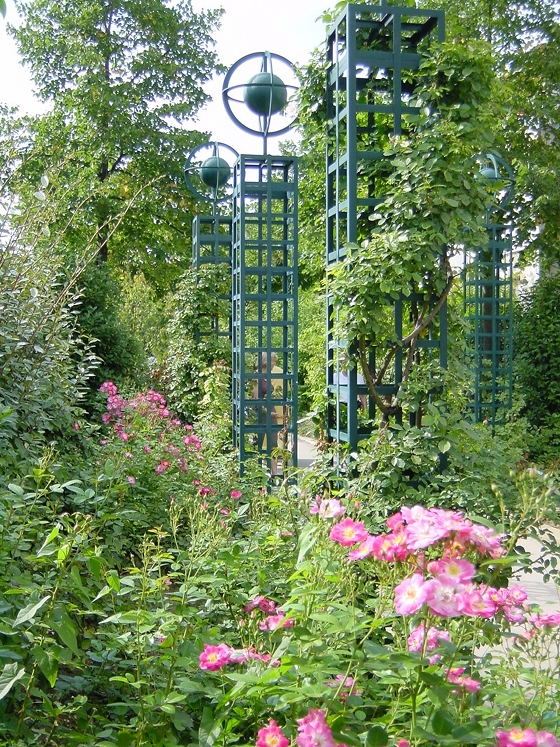
Unlike the High Line, heavy planting is the name of the game in Paris, keeping the immediate, at times resolutely contemporary, architectural context at arm's length
×Plans for Bloomingdale Trail in Chicago have been around since the early 1990s, but are coalescing into a more pragmatic usage for the viaduct. Chicago lacks a safe route running east from west for cyclists. The Bloomingdale Trail is almost three miles long, twice the length of the High Line, and is wide enough to accommodate bike traffic.
The Viaduc des Arts, over which the Promenade Plantée runs in part, was developed simultaneously with the elevated walkway, providing a series of workshops and other spaces for artisans
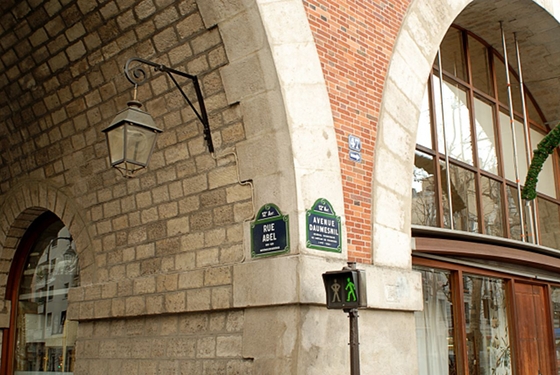
The Viaduc des Arts, over which the Promenade Plantée runs in part, was developed simultaneously with the elevated walkway, providing a series of workshops and other spaces for artisans
×In Europe, we largely continue to use the space above our viaducts for their intended use, even as we create nightclubs, shops and theatres beneath them. In Zurich, for example, Swiss architects EM2N have refurbished the space under a viaduct originally built to support the city’s early rail lines. The structure has, historically speaking, been the dividing line between the former industrial part of Zurich and the city centre. EM2N’s design attempts to unite the two areas and make the viaduct somewhat of a destination through the creation of retail and cultural spaces within its arches. Above, bubble-like skylights have been introduced to allow natural daylight in. A large food market called the Markthalle, which sits next to the viaduct, is due to open in September 2010 as part of the overall project. But for all of this, the Swiss project doesn't offer the same dynamic engagement with urbanism, that mass invitation to view and engage with the city anew from an elevated perspective.
It's a different story in America, however, where viaducts are becoming a whole new means of rethinking urban life.














